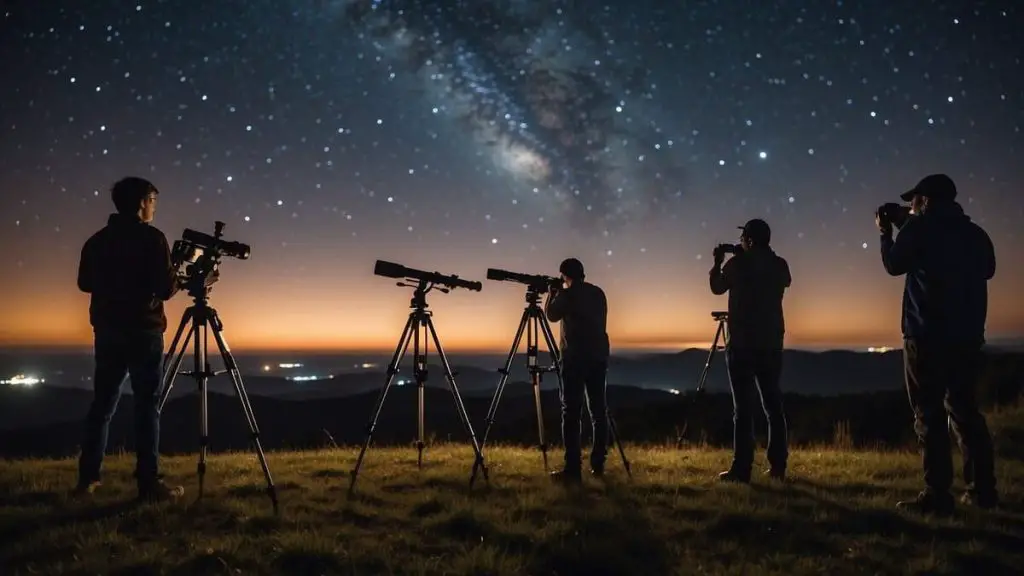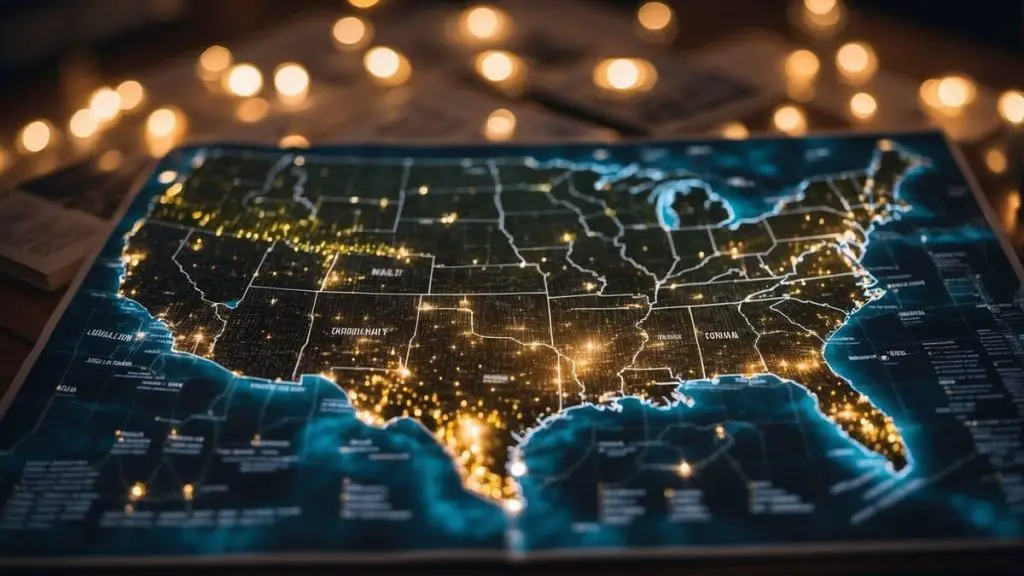In South Carolina, light pollution is more than a minor nuisance. It’s a significant issue that hampers your stargazing experience, obscuring the natural beauty of the night sky.
This problem isn’t just about diminished celestial views; it’s a broader ecological concern. Light pollution disrupts wildlife and affects human health. Finding those perfect spots for stargazing in South Carolina seems increasingly challenging.
Fear not; this article is your guide. I’ll show you how to navigate light pollution in South Carolina. You’ll learn to use light pollution maps effectively, understand their impact, and discover dark sky preserves. Let’s reclaim the night sky together!
Key Things to Know:
- Light pollution in South Carolina affects stargazing and wildlife.
- Dark sky parks and reserves offer the best views of the stars.
- Light pollution maps guide you to areas with the least sky glow.
- Efforts like IDA certification help preserve dark skies.
Understanding Light Pollution Map South Carolina

In South Carolina (SC), light pollution is a growing concern. It’s the extra glow you see over big towns and cities at night. This glow can drown out the starry sky. This glow has often drowned out the starry skies during my observations. Light pollution is not only about not seeing stars; it affects animals, too.
- Sky Brightness: During my stargazing sessions, I’ve noted the varying brightness of the night sky. In cities, the sky looks brighter because of all the lights. You might see a darker sky and more stars if you’re away from city lights.
Here are some things you can look for:
- Glow Over Cities: From my experience, this glow is particularly noticeable from elevated areas.
- Fewer Stars: In my city observations, I often see only the brightest stars.
- Color of the Sky: A truly dark sky is deep black, while polluted skies can look orange or pink.
The good news is that there are places in SC with dark skies where you can enjoy the stars. You can find maps online that show dark sky locations. If you like stargazing, these maps can guide you to the right spots.
Some tips to reduce light pollution:
- Use outdoor lights that point down.
- Turn off lights when you don’t need them.
- Choose lights that are not too bright.
Remember, every bit helps. By cutting down on light pollution, you can bring out the beauty of the night sky!
Mapping Light Pollution

When I look up at the night sky in South Carolina, I rely on light pollution maps to find where the stars shine the brightest. These maps help you find the best spots for stargazing.
Introduction to Light Pollution Maps
Light pollution maps have been crucial in my stargazing, showing where artificial light affects the night sky. The brighter the area on the map, the harder it is to see stars. A light pollution map can be a big help for stargazers in South Carolina.
You can use these maps to:
- Find dark skies for the best stargazing experience.
- Understand how city lights change what you can see in the night sky.
- Plan trips to places with less light pollution.
Using the Bortle Scale to Interpret Maps

From my use, the Bortle Scale is an effective measure of light pollution in the sky. It ranges from 1 to 9, with 1 being the darkest sky possible. When you look at a light pollution map, they often use the Bortle Scale to:
- Show different levels of sky brightness as colors.
- Help you compare viewing conditions in different areas.
For example, places with a Bortle Scale rating of 1 or 2 are perfect for seeing the Milky Way. As the numbers increase, more light pollution makes it harder to see stars.
Dark Sky Preservation Efforts

In South Carolina, protecting the night sky from light pollution is a combined effort of certifications, preserving natural spaces, and community action. Let’s explore how these efforts are helping to keep the stars shining brightly for everyone.
International Dark-Sky Association (IDA) Certification
The International Dark-Sky Association, or IDA, leads the charge in certifying places with an exceptional quality of starry nights. These are areas that have made a solid commitment to dark sky preservation.
Gaining IDA certification involves:
- Minimizing light pollution
- Promoting public education about the importance of dark skies
Dark Sky Parks and Reserves in South Carolina
You can witness the zenith of the night sky’s beauty in South Carolina’s dark sky parks and reserves.
These areas are:
- Perfect for stargazing
- Protected from artificial light
- Celebrated for their natural darkness
Legislation and Community Actions
Local laws and community initiatives play a big part in reducing light pollution.
Together, they aim to:
- Encourage the use of better lighting
- Protect wildlife habitats affected by artificial light
DarkSky International, among other organizations, also helps by educating and advocating for dark sky conservation to ensure that the night sky can be enjoyed by future generations.
Recreational Astronomy in South Carolina

In South Carolina, you can see the night sky like never before. From my experience, stargazing and astrophotography are incredible ways to enjoy South Carolina’s natural beauty after dark.
Stargazing Opportunities
South Carolina is home to many dark sky locations where you can stargaze.
Here’s what you need to know:
- State Parks: Visit places like Congaree National Park, which has low light pollution, making it perfect for seeing the stars.
- Forests: The state also boasts large areas of forested land that offer a clear view of the heavens.
As you plan your stargazing trip, check out light pollution maps for the best spots near you. They’ll show you where you can find the darkest skies.
FREE STARGAZING CHECKLIST
My 5-page Stargazing Checklist will enhance your astronomical observations.
Follow this free checklist to navigate the night sky with confidence, clarity, and a sense of preparedness for a rewarding stargazing experience.

Astrophotography Hotspots
If you love taking photos of the night sky, here are some top places in South Carolina:
- Parks: Ideal for setting up your camera and capturing the stars.
- Nearby Observatories: Experts already scouted great spots and often have less light pollution.
Look at some light pollution maps to find the prime locations where the Milky Way looks its best. You can see everything from constellations to distant galaxies with your camera when you find the right spot.
Impacts of Light Pollution

Light pollution goes beyond just making it hard to see stars. It harms humans and animals in ways you might not expect.
Effects on Human Health
- Sleep Trouble: Bright lights at night can mess up your body’s clock. This makes it hard for you to fall asleep, leading to poor sleep quality.
- Well-being: Too much artificial light could be linked to headaches, stress, and even sadness.
Consequences for Wildlife
- Changing Behaviors: Wildlife, like birds and turtles, can get confused by city lights. They might migrate at the wrong time or head toward danger instead of safe places.
- Habitat Disruption: Unnatural lighting changes which parts of the habitat are safe for animals and can lead to the loss of places to live or find food.
Light pollution affects everything, from the stars you see at night to clouds glimmering from city glow. Remember this next time you look up at the sky or install outdoor lighting. Change starts with you.
Resources and Further Reading

When you’re eager to learn about light pollution in South Carolina and its effects on astronomy, excellent resources are available. Understanding how artificial light affects our view of the stars is critical for any skywatcher. Here’s a handy list to help you:
- Understand Light Pollution: Start with an overview from the Clear Sky Charts. It’ll show you light pollution levels in South Carolina. It uses colors to rate the pollution, so you can find darker skies more easily.
- Discover Dark Sky Parks: If you want to find the best spots for stargazing in South Carolina, check out guides to South Carolina Dark Sky Parks. You’ll see maps that match sky brightness to the Bortle scale.
- Interactive Maps: To dive deeper, use the interactive world light pollution map. It’s a tool that layers different data types, including NASA VIIRS and the Bortle scale, to help you pinpoint ideal locations for stargazing.
- Learn About the Bortle Scale: For a bit of learning, read through this explanation on the Bortle Scale. It’ll give you insight into determining the darkness of your night sky, which is super helpful in planning your stargazing nights.
Remember to save these resources for a night when the stars are calling. They’re easy to use and will lead you to darker skies for better views of the cosmos. Happy stargazing!
Frequently Asked Questions
How can I get involved in local efforts to reduce light pollution?
To get involved in local efforts to reduce light pollution, you can join or initiate community projects focused on educating others about the importance of dark skies. Participate in local government meetings to advocate for better lighting policies and support initiatives by organizations like DarkSky International.
Are there specific types of lights that contribute most to light pollution?
Yes, certain types of lights contribute more to light pollution, especially unshielded bright white LED lights. These lights scatter more light across the sky instead of directing it downward. Choosing warmer-colored, shielded lights reduces their impact on the night sky.
Can light pollution impact my health, and how?
Light pollution can indeed impact your health, particularly your sleep patterns. Excessive exposure to artificial light at night can disrupt your body’s circadian rhythm, leading to sleep disturbances and potentially affecting overall well-being. Reducing nighttime light exposure can help mitigate these effects.
TL;DR
- Light pollution in South Carolina is a significant issue affecting stargazing experiences and wildlife.
- Dark sky parks and reserves in South Carolina offer the best opportunities for observing the night sky in its natural state.
- Light pollution maps are essential for finding the least polluted areas and planning stargazing or astrophotography trips.
- Efforts to reduce light pollution include IDA certification, community initiatives, and eco-friendly lighting.
- Understanding the impact of light pollution on the environment and human health is crucial for preserving the natural beauty of the night sky.
Your insights and queries are the stars that guide this journey of celestial discovery. Whether you have a burning question or a sparkling comment, please share it in the comments section below.
Let’s illuminate our understanding of the night sky together!




